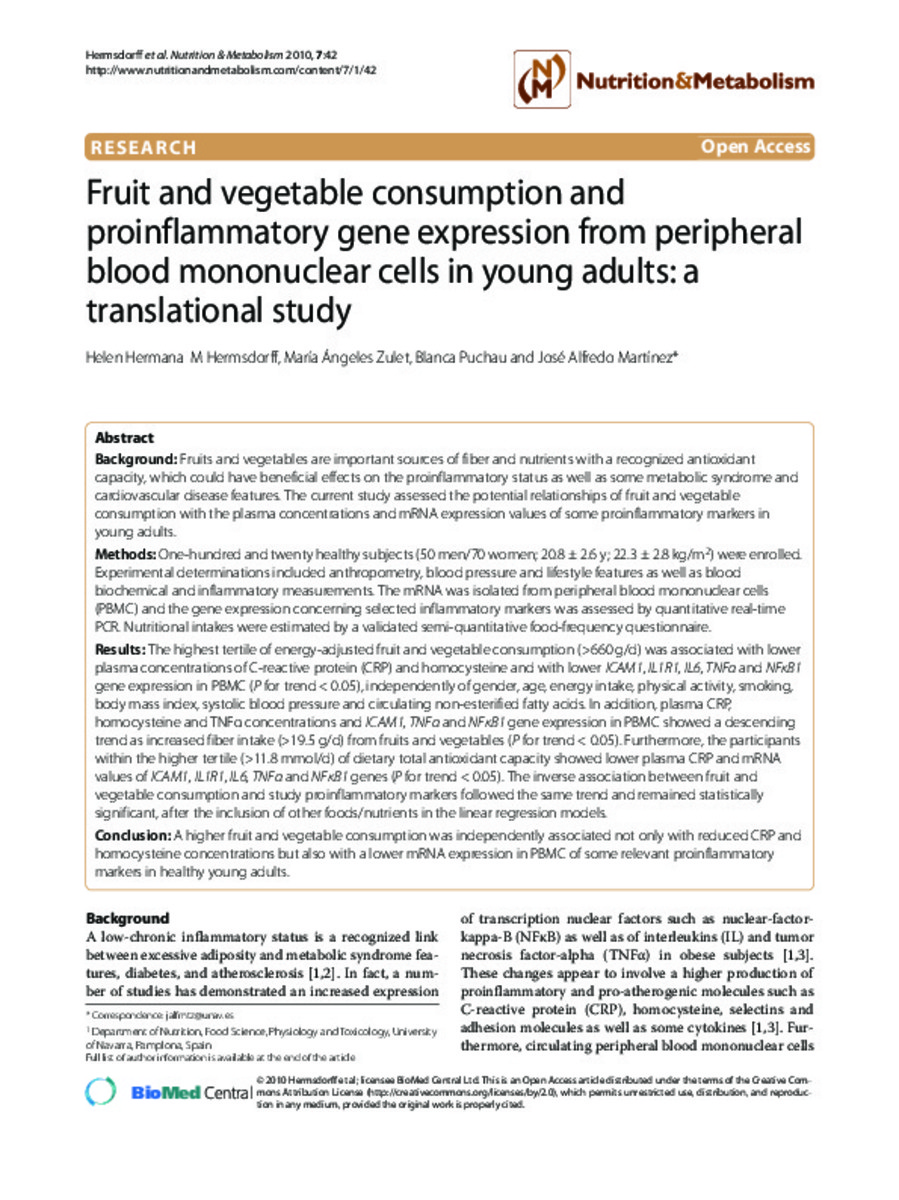Full metadata record
| DC Field | Value | Language |
|---|---|---|
| dc.creator | Hermsdorff, H.H. (H. H.) | - |
| dc.creator | Zulet, M.A. (María Ángeles) | - |
| dc.creator | Puchau, B. (Blanca) | - |
| dc.creator | Martinez, J.A. (José Alfredo) | - |
| dc.date.accessioned | 2013-04-15T15:21:20Z | - |
| dc.date.available | 2013-04-15T15:21:20Z | - |
| dc.date.issued | 2010 | - |
| dc.identifier.citation | Hermsdorff HH, Zulet MA, Puchau B, Martinez JA. Fruit and vegetable consumption and proinflammatory gene expression from peripheral blood mononuclear cells in young adults: a translational study. Nutr Metab (Lond) 2010 May 13;7:42. | es_ES |
| dc.identifier.issn | 1743-7075 | - |
| dc.identifier.uri | https://hdl.handle.net/10171/28282 | - |
| dc.description.abstract | BACKGROUND: Fruits and vegetables are important sources of fiber and nutrients with a recognized antioxidant capacity, which could have beneficial effects on the proinflammatory status as well as some metabolic syndrome and cardiovascular disease features. The current study assessed the potential relationships of fruit and vegetable consumption with the plasma concentrations and mRNA expression values of some proinflammatory markers in young adults. METHODS: One-hundred and twenty healthy subjects (50 men/70 women; 20.8 +/- 2.6 y; 22.3 +/- 2.8 kg/m2) were enrolled. Experimental determinations included anthropometry, blood pressure and lifestyle features as well as blood biochemical and inflammatory measurements. The mRNA was isolated from peripheral blood mononuclear cells (PBMC) and the gene expression concerning selected inflammatory markers was assessed by quantitative real-time PCR. Nutritional intakes were estimated by a validated semi-quantitative food-frequency questionnaire. RESULTS: The highest tertile of energy-adjusted fruit and vegetable consumption (>660 g/d) was associated with lower plasma concentrations of C-reactive protein (CRP) and homocysteine and with lower ICAM1, IL1R1, IL6, TNFalpha and NFkappaB1 gene expression in PBMC (P for trend < 0.05), independently of gender, age, energy intake, physical activity, smoking, body mass index, systolic blood pressure and circulating non-esterified fatty acids. In addition, plasma CRP, homocysteine and TNFalpha concentrations and ICAM1, TNFalpha and NFkappaB1 gene expression in PBMC showed a descending trend as increased fiber intake (>19.5 g/d) from fruits and vegetables (P for trend < 0.05). Furthermore, the participants within the higher tertile (>11.8 mmol/d) of dietary total antioxidant capacity showed lower plasma CRP and mRNA values of ICAM1, IL1R1, IL6, TNFalpha and NFkappaB1 genes (P for trend < 0.05). The inverse association between fruit and vegetable consumption and study proinflammatory markers followed the same trend and remained statistically significant, after the inclusion of other foods/nutrients in the linear regression models. CONCLUSION: A higher fruit and vegetable consumption was independently associated not only with reduced CRP and homocysteine concentrations but also with a lower mRNA expression in PBMC of some relevant proinflammatory markers in healthy young adults. | es_ES |
| dc.language.iso | eng | es_ES |
| dc.publisher | BioMed Central | es_ES |
| dc.rights | info:eu-repo/semantics/openAccess | es_ES |
| dc.subject | Proinflammatory markers | es_ES |
| dc.subject | Vegetable consumption | es_ES |
| dc.subject | Fruit consumption | es_ES |
| dc.subject | C-reactive protein | es_ES |
| dc.subject | mRNA expression | es_ES |
| dc.title | Fruit and vegetable consumption and proinflammatory gene expression from peripheral blood mononuclear cells in young adults: a translational study | es_ES |
| dc.type | info:eu-repo/semantics/article | es_ES |
| dc.type.driver | info:eu-repo/semantics/article | es_ES |
| dc.identifier.doi | http://dx.doi.org/10.1186/1743-7075-7-42 | es_ES |
Files in This Item:
Statistics and impact
Items in Dadun are protected by copyright, with all rights reserved, unless otherwise indicated.






